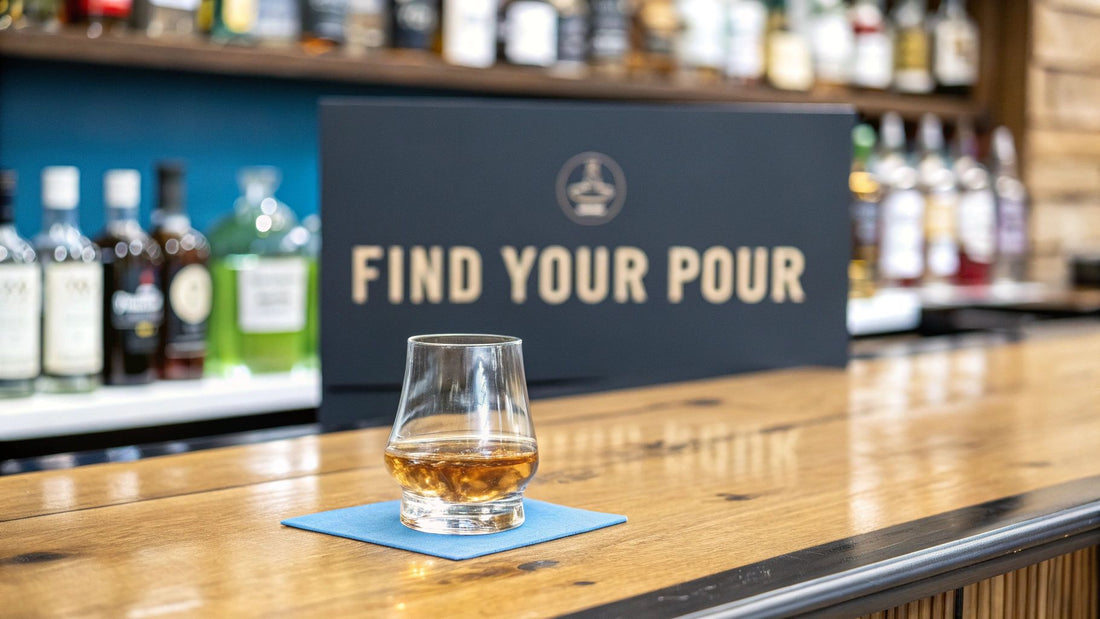Asking "what's the best whiskey?" is a lot like asking "what's the best song?"—the answer is always going to be deeply personal.
Sure, critics can crown a rare Scotch or a limited-edition Bourbon as the champion, but the truth is, the best whiskey is simply the one you enjoy drinking the most. It’s not about finding a single ‘correct’ bottle. It's about starting an exciting journey to discover your own palate.
Defining Your Personal Best Whiskey
Let's get one thing straight: there's no single champion whiskey that rules them all. The real quest is about finding what delights your taste buds.
What one person loves for its intense, smoky character, another might find completely overwhelming. They might prefer a smoother, sweeter profile instead. Shifting your focus from finding the right answer to exploring what's right for you is the first, and most important, step for any new whiskey drinker.
This journey is shaped by a handful of key personal preferences. It’s less about what experts on a panel say and more about how you answer a few simple questions for yourself. Think of it as creating a flavor roadmap that leads directly to your perfect pour.
Key Factors in Your Whiskey Choice
To get started, let’s break down the three main elements that will guide your selection. Nailing these down will help you cut through the noise and narrow the vast world of whiskey down to a few bottles you’re likely to love.
- Flavor Profile: Are you drawn to sweet, dessert-like notes of caramel and vanilla? Do you prefer the bold, peppery kick of spice? Or does the rustic, campfire aroma of a smoky whiskey sound more your speed? Identifying which camp you fall into is a massive shortcut.
- Serving Style: How do you actually plan to drink it? A high-proof, complex whiskey might be perfect for sipping neat, letting all its nuances shine. On the other hand, a smoother, more approachable bottle is often ideal for cocktails like an Old Fashioned. Your intended use really matters.
- Budget: You don’t need to spend a fortune to find a fantastic whiskey. I promise. Great options exist at every price point, from accessible American craft distillery releases all the way up to premium, aged expressions.
This concept map really brings it all together, illustrating how these personal factors—flavor, serving style, and budget—interlock to define your ideal whiskey.
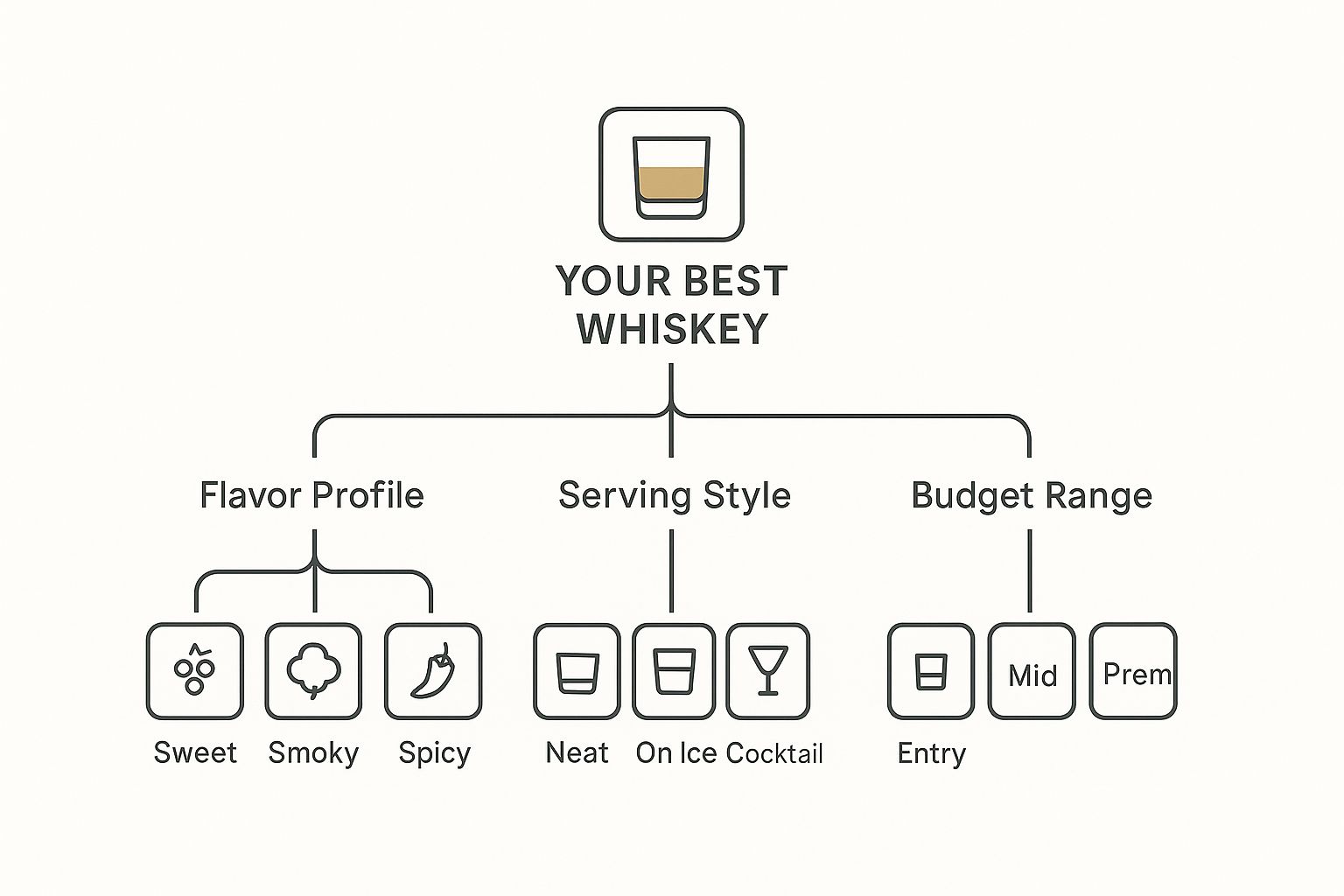
As the visual shows, these three pillars are completely interconnected. They help you build a clear picture of your personal "best." Once you understand your preferences, you can navigate the whiskey aisle with real confidence.
To get even more specific, you can learn to pinpoint exact flavors with a simple guide to using a whiskey tasting notes template. This kind of tool empowers you to articulate what you like and dislike with much greater precision, making every new bottle a valuable learning experience.
Quick Guide to Common Whiskey Flavors
To give you a running start, here's a quick cheat sheet. Use this table to match common whiskey types with the flavors you already know you enjoy.
| Whiskey Type | Primary Grains | Common Flavor Notes | A Good Match If You Like... |
|---|---|---|---|
| Bourbon | Corn (at least 51%) | Caramel, vanilla, oak, baking spices | Sweet desserts, rum, creme brûlée |
| Rye Whiskey | Rye (at least 51%) | Black pepper, cinnamon, mint, dill | Spiced baked goods, bold red wines |
| Scotch (Islay) | Malted Barley | Peat smoke, iodine, brine, seaweed | Campfires, smoked meats, Lapsang souchong tea |
| Scotch (Speyside) | Malted Barley | Apple, pear, honey, floral notes | Orchard fruits, light white wines, honey |
| Irish Whiskey | Malted & Unmalted Barley | Light fruit, vanilla, honey, floral | Green apples, shortbread cookies, light beer |
This isn't an exhaustive list, of course, but it’s a great way to find a starting point on your journey. See a flavor profile you like? That's your cue to grab a bottle from that category and start exploring.
A World Tour of Whiskey Styles
Where a whiskey comes from tells you a massive story about its taste. Think of it as your passport to the world's most important whiskey regions, each with its own personality stamped right on the bottle. The local grains, the climate, and centuries of tradition all come together to shape the spirit you’re about to pour.
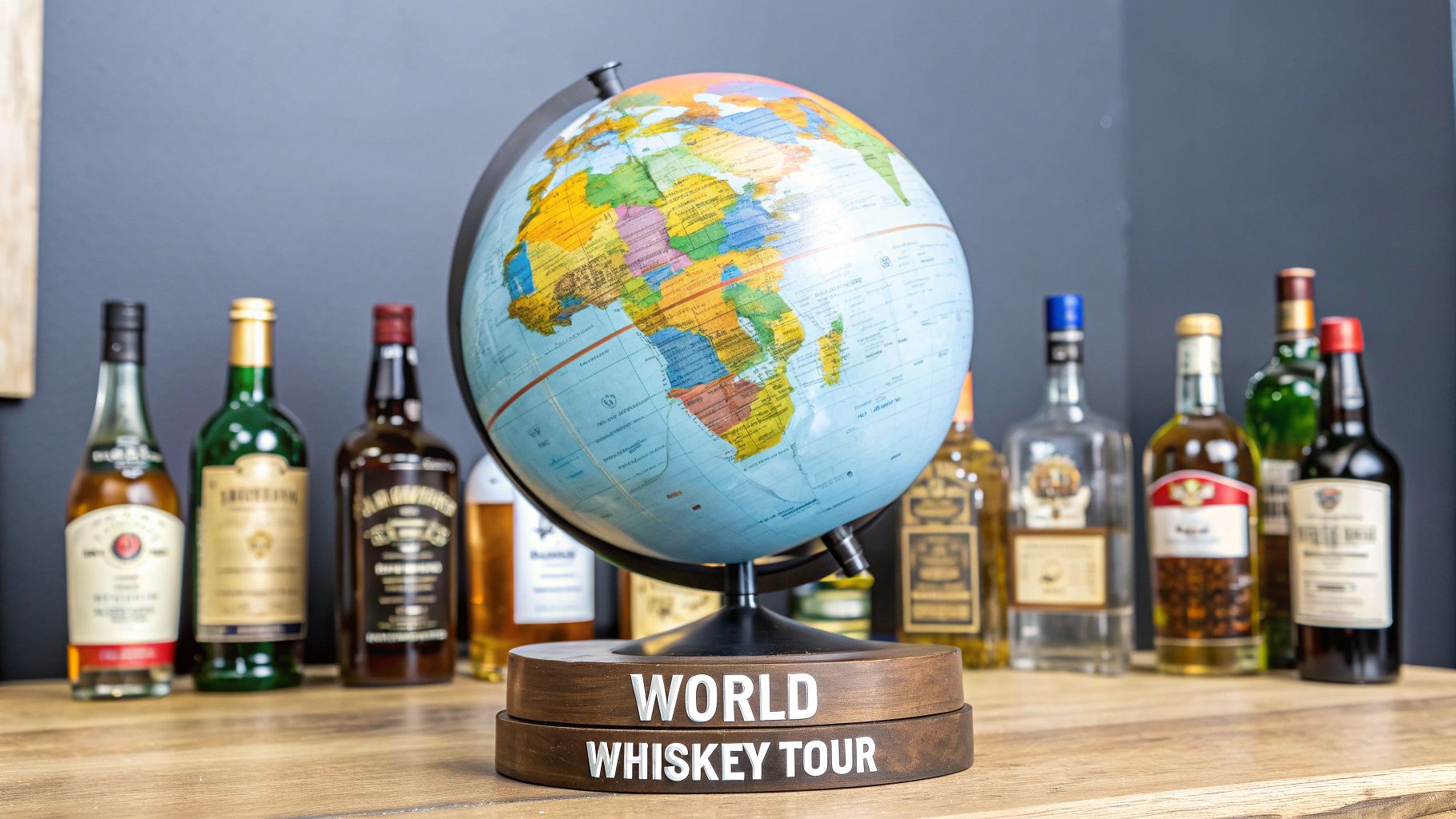
Getting a handle on these regional styles is a huge shortcut to finding your perfect whiskey. Once you know you like the vibe from a certain country, you can start exploring other bottles from that area with a lot more confidence.
Starting in America
American whiskey is a fantastic place to begin, especially for newcomers. It's known for approachable and bold flavors that are easy to get to know. The two big players here are Bourbon and Rye, and telling them apart is pretty straightforward.
- Bourbon: Since it has to be made primarily from corn, Bourbon has a signature sweet and rich character. You'll find notes of caramel, vanilla, and toasted oak. It’s the comfortable, friendly face of American whiskey.
- Rye: This style puts rye grain front and center, which means you get a much bolder, spicier kick. Look for notes of black pepper, mint, and cinnamon that create a zesty, robust profile.
Lots of American craft distilleries are pushing these classic styles in exciting new directions. Brands like Laws Whiskey House in Colorado and Frey Ranch in Nevada are making some truly exceptional spirits that put their local grains on display, offering a perfect entry point for anyone new to the scene.
Crossing the Pond to Scotland
Scotch whisky is home to one of the most diverse flavor landscapes on the planet. Its character is deeply tied to the specific regions within Scotland, creating a wild spectrum of tastes from gentle and fruity to intensely smoky.
The most famous distinction comes from the use of peat—decomposed plant matter that’s burned to dry the barley. This single step can completely change a whisky, imparting a distinct smoky, earthy flavor.
Some of the most sought-after whiskies come from the island of Islay, where the peat imparts intense notes of campfire smoke, iodine, and sea salt. It’s a bold and unforgettable flavor that many connoisseurs consider the pinnacle of complexity.
If that sounds like a bit much, don't worry. The Speyside region, for instance, is famous for producing delicate and fruity malts with notes of apple, honey, and floral heather. Understanding peat is key to unlocking Scotch, and you can dive deeper in our guide explaining what peaty Scotch is.
Irish and Japanese Whiskey
To round out our tour, we have two more essential styles. Each one is prized for its unique production methods and the delicious flavors that result.
Irish Whiskey
Often called the smoother cousin of Scotch, Irish whiskey is typically triple-distilled, whereas Scotch usually goes through just two distillations. This extra step creates a lighter, smoother, and exceptionally clean spirit. Common notes include light fruit, vanilla, and a gentle, biscuity sweetness that makes it incredibly easy to drink.
Japanese Whisky
Initially inspired by Scottish traditions, Japanese whisky has earned a global reputation for its incredible balance and elegant craftsmanship. Japanese distillers are obsessed with precision and harmony, creating whiskies that are complex yet impeccably smooth. Their profiles can range from light and floral to rich and subtly smoky, but they always finish with a signature refinement.
Why American Whiskey Is a Modern Contender
For a lot of whiskey drinkers, the answer to the age-old question, "what's the best?" is found right here in the States. While Scotland will always have its historical gravitas, American whiskey—especially bourbon and rye—has absolutely exploded onto the scene. It’s a perfect storm of reliable quality and bold creativity that’s pulling in everyone from the curious newcomer to the seasoned expert.
The heart of this movement is bourbon. Unlike other styles with more relaxed rules, bourbon has to follow a strict set of laws. Think of it as a quality guarantee built right into every bottle. These regulations ensure a consistent, high-quality spirit that delivers those familiar, welcoming flavors of caramel, vanilla, and oak, making it a fantastic starting point for anyone new to whiskey.
The Craft Distillery Revolution
But the real excitement in American whiskey today isn’t just about following the rules—it’s about breaking them. The vibrant craft distillery movement is where the magic is happening. Small, independent producers all over the country are pushing the creative envelope, completely reimagining what an American whiskey can be. They're the artists of the industry, experimenting with unique grain recipes, innovative aging techniques, and small-batch releases that truly taste like they came from a specific place.
This wave of innovation has created an incredibly diverse and thrilling landscape to explore. These distilleries aren't just making whiskey; they're crafting stories in a bottle. You can dive into some of the most exciting great American craft spirits to get a feel for just how dynamic this scene has become.
The United States isn't just a major producer; it's the world’s largest whiskey-consuming market, making our domestic brands serious global players. This growth is fueled by a passionate home crowd, with the U.S. whiskey segment projected to grow at a 12.7% CAGR through 2035. With over half of bourbon and rye drinkers under the age of 44, a new generation is driving this trend toward premium, interesting spirits.
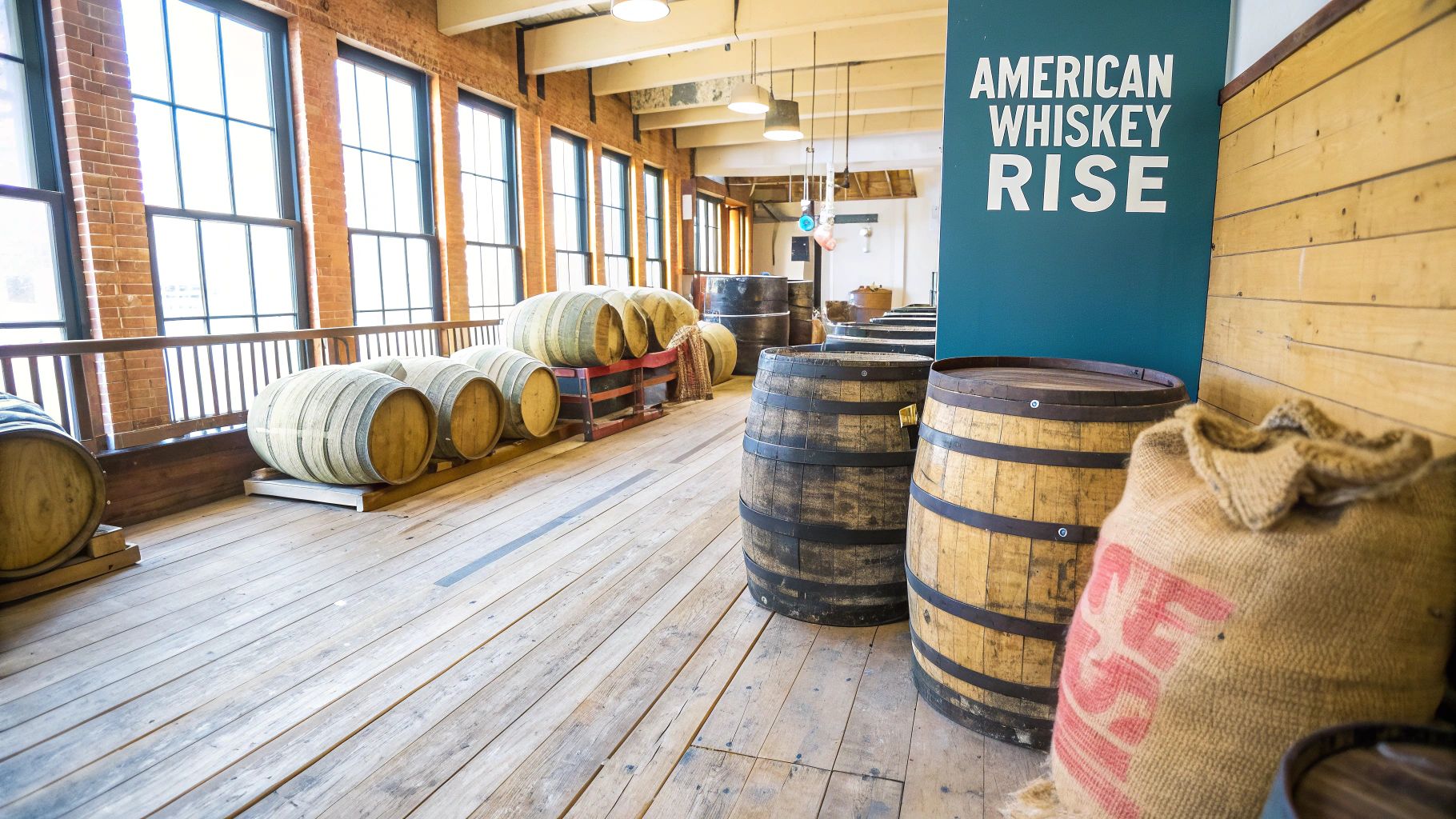
Tips for New Whiskey Drinkers
If you're just getting into whiskey, American craft brands are an accessible and rewarding place to begin. Their whole vibe is way less intimidating than some of the older, more traditional categories.
A great tip for beginners is to start with a "wheated" bourbon. These use wheat as the second grain instead of the spicier rye. The result is a softer, smoother, and slightly sweeter profile that’s incredibly easy to enjoy.
Here are a few more tips to get you started on your exploration:
- Look for grain-to-glass distilleries. Brands like Frey Ranch in Nevada or Laws Whiskey House in Colorado control their entire process, from farming the grains to bottling the spirit. This gives them incredible control and results in some truly unique and high-quality expressions.
- Don't fear the proof. A lot of craft whiskeys are bottled at a slightly higher proof. Don't let that scare you. Just add a few drops of water or a single large ice cube. This will open up the flavors and tame the alcoholic heat, letting the real character of the whiskey shine through.
- Start with a flight. If you find yourself at a good whiskey bar, ask for a flight of American craft bourbons or ryes. It’s the best way to compare different styles side-by-side and quickly figure out what you like.
Scotch Whisky: The Old World Benchmark
While American whiskey is riding a massive wave of creative energy, Scotch remains the undisputed heavyweight champion, the historic benchmark for what a world-class whiskey can be. For centuries, if you asked a connoisseur for "the best whiskey," the answer would almost certainly point you to a bottle from Scotland. This isn't just about sticking with tradition; it's about a spirit that’s profoundly, almost mystically, tied to the land where it's made.
The prestige of Scotch is built on a simple but powerful idea: regionality. Just like wine grapes taste different depending on the soil and climate, the unique character of Scotland's diverse landscapes gets baked right into its whiskies. The local water source, the way the climate shapes the aging process in the barrel, and the centuries of know-how passed down through generations—it all comes together in the bottle. Every sip is like a liquid postcard from a very specific place.
A Land of Contrasting Flavors
This concept of "terroir" is what makes diving into Scotch so endlessly fascinating. The flavor profiles can swing wildly from one region to the next, offering a dram for truly every kind of palate.
- The Highlands: Think rich, full-bodied malts. You'll often find notes of dense fruitcake, earthy heather, and just a gentle wisp of smoke.
- Speyside: This is the home of elegant, fruity, and often lighter whiskies. Look for crisp notes of apple, pear, and a touch of honey.
- Islay: Famous for its heavily peated, "smoky" Scotch. These whiskies deliver an intense punch of campfire, salty seaweed, and seaside brine. It’s a powerful style you won't soon forget.
- The Lowlands: Traditionally, this region produces soft, delicate, and lighter-bodied whiskies with grassy and floral notes, making them incredibly approachable for newcomers.
Look, it's impossible to crown a single "best" whiskey without starting a fight, but the Scotch industry has the receipts to back up its claim to fame. In 2023 alone, Scotland shipped out a staggering 1.3 billion bottles. Year after year at major competitions like the World Whisky Awards, Scotch consistently hauls in more medals than whiskies from any other country. If you want to see just how massive its global footprint is, these global whisky export trade insights really put it into perspective.
The Art of Time and Blending
Beyond geography, two more pillars hold up Scotch's legendary status: the age statement and the masterful art of the blender. An age statement on a bottle (like 12, 15, or 18 years) tells you the age of the youngest whisky used. It's a transparent guarantee of maturity that almost always translates to more complexity and a smoother drinking experience.
The master blender is the quiet hero of the Scotch world. Their job is to taste and combine whiskies from hundreds, sometimes thousands, of different casks to create a final product that is perfectly balanced and consistent year after year. It's a craft that takes a lifetime to perfect.
Even with all the incredible new things happening in American craft whiskey, you simply can't have a complete whiskey education without understanding Scotch. Its unwavering quality, stunning regional diversity, and deep respect for the craft of aging and blending are exactly why it remains a titan in any conversation about the world's best whiskey.
How to Taste Whiskey and Find Your Flavor Profile
So, are you ready to figure out what makes a whiskey your kind of "best"? The single best way to do that is to simply learn how to taste it. Don't worry, this isn't about snobbery or memorizing a bunch of jargon—it’s a straightforward process that helps you trust your own senses and pinpoint what you actually enjoy.
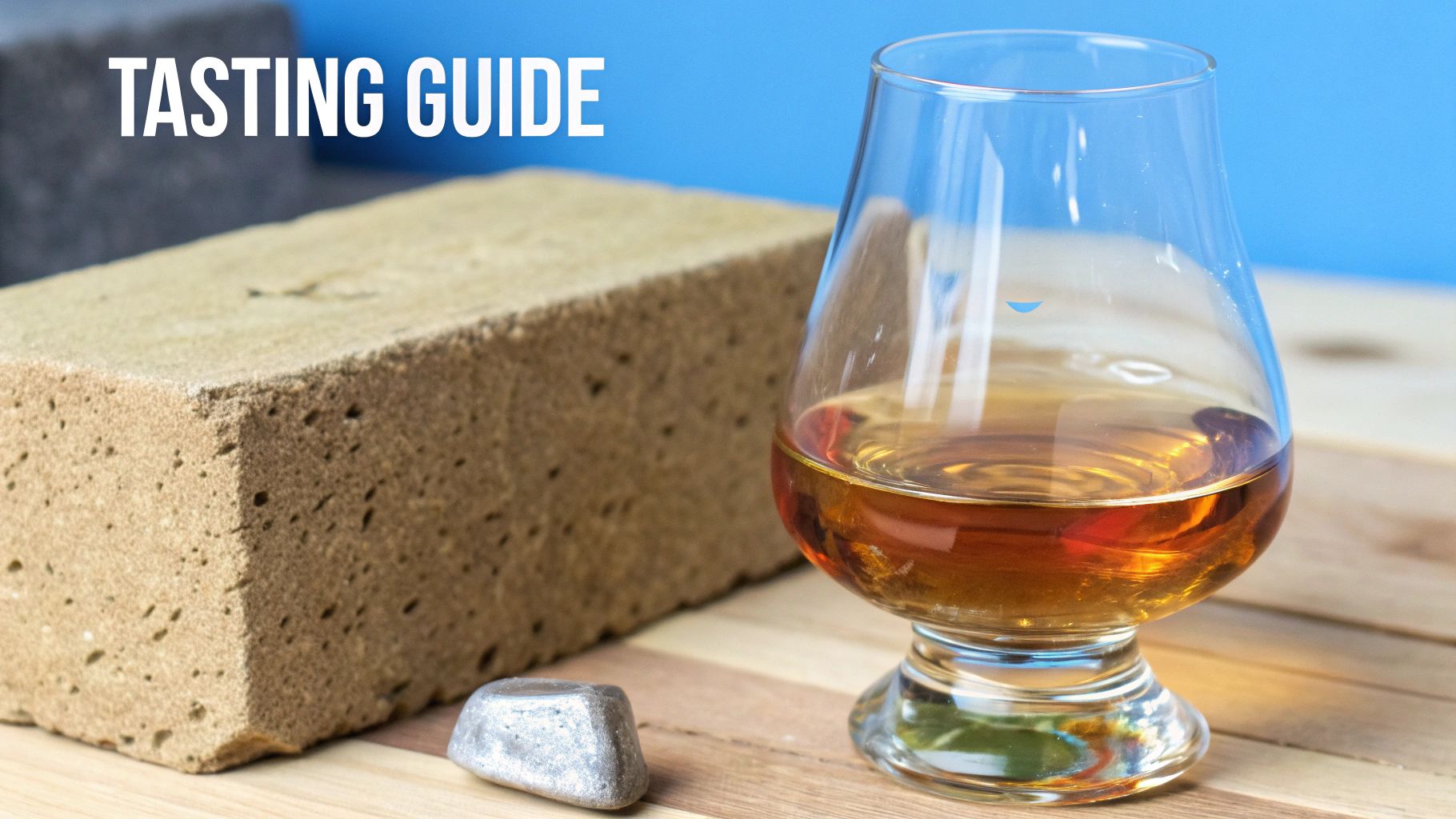
We're going to break it down into four simple steps: Look, Smell, Sip, and Savor. Think of it as building your own personal toolkit for discovery. Once you get the hang of this, you can walk into any bar or bottle shop and know exactly what you’re looking for.
Step 1: Look at the Whiskey
Before that glass even gets near your lips, hold it up to the light. The first thing you'll notice is the color, which can be anything from a pale straw to a deep, dark mahogany. That color comes almost entirely from the time it spent aging in an oak barrel.
As a general rule, a darker color hints at more time spent in that barrel, which often translates to more intense notes of oak, caramel, and vanilla. It’s not a guarantee, but it’s a fantastic first clue about the flavors waiting inside.
Step 2: Smell the Aromas
Now, give the glass a gentle swirl. This little motion helps release the aromatic compounds, essentially waking the whiskey up. Bring your nose to the rim of the glass and take a light sniff, keeping your mouth slightly open. This simple trick prevents the alcohol vapor from overwhelming your senses.
What are you picking up? Try to name specific scents. You might get sweet notes like vanilla or honey, something fruity like apple or cherry, or maybe spicy aromas like cinnamon and black pepper. This is where the whiskey’s personality really starts to emerge.
Step 3: Sip and Taste
Finally, the moment you've been waiting for. Take a small sip. Let the whiskey roll over your entire tongue for just a few seconds before you swallow. This initial taste is what drinkers call the palate, and it’s where you’ll see if the taste matches the smell.
Pay attention to the texture, or mouthfeel. Is it light and crisp? Or is it rich, oily, and thick? As you hold it, other flavors will come forward. Maybe that initial sweetness fades into a spicy rye kick, or a smoky, earthy character takes over.
A Tip for New Whiskey Drinkers: If the alcohol feels a bit too strong, add just a few drops of water. This can dramatically tame the "burn" and unlock a whole new layer of subtle flavors and aromas that were hiding behind the proof.
Step 4: Savor the Finish
The last piece of the puzzle is the finish—the flavors and sensations that linger after you’ve swallowed. Does the taste vanish right away, or does it leave a long, warming trail of oak and spice down your throat?
A long, complex finish is often the sign of a really well-made spirit. It's the final impression the whiskey leaves you with, and it’s a huge part of the overall experience. By paying attention to these four steps, you'll start building a mental library of what you like and dislike in no time.
You can put these skills to the test with American craft brands, which are known for their expressive character. For instance, a "grain-to-glass" bourbon from a distillery like Frey Ranch might deliver a clear, sweet corn and caramel palate. On the other hand, a rye from Sagamore Spirit will almost certainly hit you with that signature peppery spice all the way through the finish. The more you practice, the more confident you'll be in finding your perfect pour.
We’ve given you the map—now it’s time to actually start the adventure.
The hunt for "the best whiskey" isn't about a single bottle. It's about enjoying the exploration. Your mission is to have fun, try new things, and discover what truly delights your palate, one sip at a time. The perfect pour is out there waiting for you.
Where to Begin Your Tasting Journey
Ready to dive in? Here are a few simple, foolproof ways to start tasting and figuring out what you actually enjoy. These are perfect if you're new to the whiskey world and want an easy way in.
- Order a Tasting Flight: Head to a local whiskey bar and ask for a flight. This is the fastest way to compare several styles side-by-side, helping you pinpoint what you like (and don't) without committing to a whole bottle.
- Explore American Craft Whiskey: Forget the big names for a minute and grab a bottle from an approachable American craft distillery. Brands like Laws Whiskey House or Frey Ranch are putting out incredible stuff that serves as a perfect introduction to modern, flavorful whiskey.
- Mix a Simple Cocktail: Making a classic cocktail, like an Old Fashioned, is a fantastic way to get to know a whiskey's backbone in a more forgiving format. You’ll see how its core flavors stand up when mixed.
Still Have Questions About Finding the Best Whiskey?
Let's tackle some of the most common questions that come up when you're just starting your whiskey journey. Getting these cleared up will help you zero in on what you actually enjoy.
Does a Higher Price Always Mean Better Whiskey?
Absolutely not. While a hefty price tag can signal rarity or a seriously long time spent in a barrel, it's no guarantee that you'll actually like it more. Some of the most exciting, flavor-packed whiskeys winning awards today are younger and won't break the bank.
This is especially true in the world of American craft whiskey. You have incredible distilleries focusing on top-notch grains and meticulous craftsmanship rather than just hitting a certain age statement. At the end of the day, the "best" whiskey is the one that tastes best to you, not the one with the most zeroes on its price tag.
What Is the Best Way to Drink Whiskey for a Beginner?
There's really no wrong way, but a great place to start is with a splash of water or one large ice cube. Just a little dilution can be magical—it dials back the alcohol's heat, letting the subtle flavors and aromas step forward without that initial "burn."
Another pro tip for newcomers is to try whiskey in a classic cocktail, like an Old Fashioned. It's a fantastic way to get to know a whiskey's backbone in a more familiar and approachable format. Don't be afraid to experiment and see what clicks for you.
What Are Some Good American Craft Whiskeys to Start With?
Diving into accessible, high-quality brands is a smart move. These distilleries are at the forefront of the innovation happening across the country and offer a perfect gateway into the hobby.
- For Bourbons: Keep an eye out for distillers like Laws Whiskey House or Frey Ranch. They've built their reputations on using incredible grains to create exceptionally well-balanced bourbons.
- For Ryes: If rye's signature spice has you curious, brands like High West or Sagamore Spirit are a perfect introduction. They deliver that classic rye character without being overwhelming.
Ready to cut through the hype and let your own palate be the judge? At Blind Barrels, we send you four mystery samples of top-shelf American craft whiskey every quarter. It's the ultimate way to discover your next favorite bottle based purely on taste, not labels. Start your blind tasting journey today at BlindBarrels.com.
